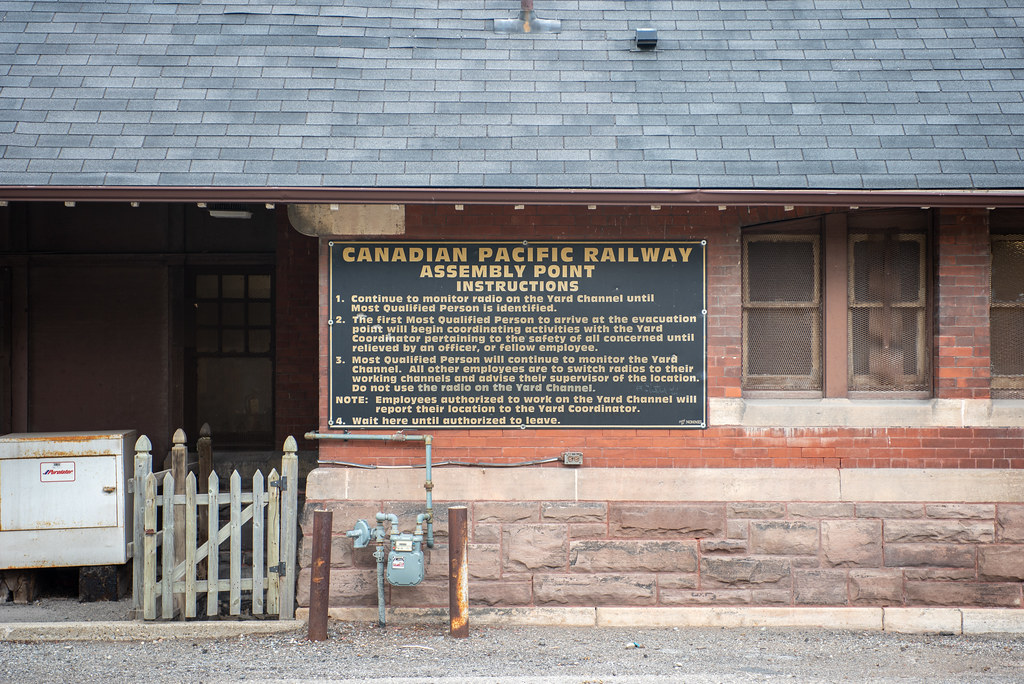When looking for train stations in Woodstock, most people are quick to point you in the direction of the VIA station. While it certainly gets the most attention, a second station has sat on the other side of the downtown and remains in operation today. Thanks to the members of John Cowen’s Classic Railfan group on Facebook for filling in some of the gaps in this station’s history.

Graflex Crown Graphic – Fuji Fujinon-W 1:5.6/125 – Ilford HP5+ @ ASA-200 – Pyrocat-HD (1+1+100) 9:00 @ 20C
When the Credit Valley Railway was chartered in the 1870s, its primary goal was to construct a line from Toronto to Orangeville. The completion of the Canadian Southern Railway line saw the backers of Credit Valley look west as Canadian Southern could provide access to the United States. The earliest section of this branch from Streetsville to St. Thomas opened between Woodstock and Ingersoll in 1876; a year later, the line from Parkdale to Milton opened, and the first revenue train to St. Thomas rolled through in 1879. In addition to freight, passenger service provided additional revenue. While there is no visual record of the first Credit Valley Station in Woodstock that I could find, surviving documents show a Woodstock station on the Credit Valley line. A good chance it appeared similar to the surviving Streetsville Junction Station. By 1884 the line came under the control of Canadian Pacific, which acquired it through its paper firm Ontario & Quebec Railway. The railway allowed for a second industrial station to form around the line. Canadian Pacific opened a yard south of the station with storage tracks, a turntable and a small roundhouse.

Nikon D750 – AF-S Nikkor 28-70mm 1:2.8D
Nikon D750 – AF-S Nikkor 28-70mm 1:2.8D
By the 1890s Canadian Pacific began a series of programs to modernise their locomotive fleet and stations. To complete this, they retained noted Montreal architect Edward Maxwell to design a standard station plan that they could build to replace many of the old stations. Maxwell’s designs laid heavily on Romanesque combined with Arts & Craft styles. The stations followed the same rectangular footprint with a general waiting room, station agent and the ticket office, and a telegraph bay. The remainder of the station contained the baggage room. A freight shed would remain a separate building. Woodstock’s new station opened in 1899, a fitted limestone foundation with red brick, wooden trim and a low, broad roof painted a Tuscan brown with cream highlights. Unobtrusive with a quiet domestic quality provided a handsome, easily accessed station for the local population. And it proved a popular passenger station as it allowed direct access to Toronto and further west points. The move towards diesel resulted in the demolition of the roundhouse in the 1960s, and the Woodstock station proved a popular spot for Canadian Pacific Rail Desiel Cars or Dayliners for commuter traffic. The final passenger train left in 1971.

Nikon D300 – AF-S Nikkor 14-24mm 1:2.8G
Nikon D300 – AF-S Nikkor 14-24mm 1:2.8G
Despite ending passenger service, the position of the station on the Canadian Pacific mainline saw it being maintained as a control office for Canadian Pacific. Canadian Pacific removed the station’s platform and one track would be pulled up, but the station fell into quiet administrative work. Canadian Pacific continued to maintain operations on the line through to the 1990s when the track began part of Ontario Southland, a Short-Line operator that runs the fifty-one-kilometre stretch from Woodstock to St. Thomas; around this time, the old freight shed came down. Today the station remains an active Canadian Pacific office and has changed little, aside from an entrance lean-to and even has some excellent Canadian Pacific signage on the exterior. The ease of view makes it a popular spot for railfans to watch trains.